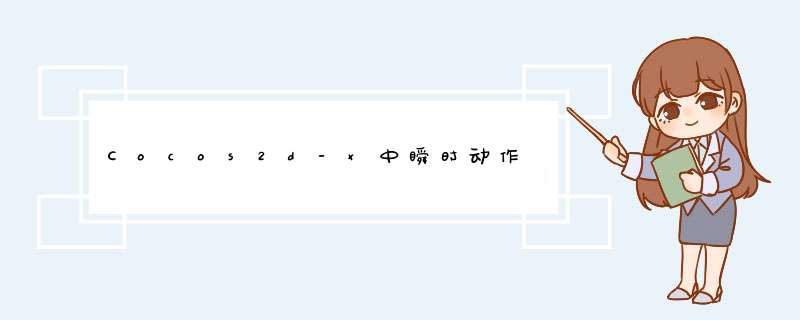
瞬时动作就是不等待立即执行的动作,瞬时动作的基类是ActionInstant ,具体类图参见cocos2d的文档
我们通过一个实例来学习cocos2d-x中的瞬时动作
首先在HelloWorld.h头文件中添加枚举,用来作为选择的标识
typedef enum ActionTypes
{
PLACE_TAG = 102,
FliPX_TAG,
FliPY_TAG,
HIDE_SHOW_TAG,
TOGGLE_TAG
};
然后在init中添加菜单选项,并关联回调函数
bool HelloWorld::init(){ ////////////////////////////// // 1. super init first if ( !Layer::init() ) { return false; } Size visibleSize = Director::getInstance()->getVisibleSize(); Vec2 origin = Director::getInstance()->getVisibleOrigin(); auto bg = Sprite::create("Background800x480.png"); bg->setposition(Vec2(origin.x + visibleSize.wIDth / 2,origin.y + visibleSize.height / 2 )); this->addChild(bg); auto placeLable = Label::createWithBMFont("Fonts/fnt2.fnt","Place"); auto placeMenu = MenuItemLabel::create(placeLable,CC_CALLBACK_1(HelloWorld::OnclickMenu,this)); placeMenu->setTag(PLACE_TAG); auto flipXlabel = Label::createWithBMFont("Fonts/fnt2.fnt","FlipX"); auto flipXmenu = MenuItemLabel::create(flipXlabel,this)); flipXmenu->setTag(FliPX_TAG); auto filpYlabel = Label::createWithBMFont("Fonts/fnt2.fnt","FlipY"); auto flipYmenu = MenuItemLabel::create(filpYlabel,this)); flipYmenu->setTag(FliPY_TAG); auto hIDeLabel = Label::createWithBMFont("Fonts/fnt2.fnt","HIDe and Show"); auto hIDeMenu = MenuItemLabel::create(hIDeLabel,this));; hIDeMenu->setTag(HIDE_SHOW_TAG); auto toggleLabel = Label::createWithBMFont("Fonts/fnt2.fnt","toggle"); auto toggleMenu = MenuItemLabel::create(toggleLabel,this)); toggleMenu->setTag(TOGGLE_TAG); auto mn = Menu::create(placeMenu,flipXmenu,flipYmenu,hIDeMenu,toggleMenu,NulL); mn->alignItemsvertically(); this->addChild(mn); return true;} voID HelloWorld::OnclickMenu(cocos2d::Ref *pSender){ MenuItem *mnItem = (MenuItem*)pSender; auto sc = Scene::create(); auto Layer = MyAction::create(); Layer->setTag(mnItem->getTag()); sc->addChild(Layer); auto reScene = TransitionSlIDeInR::create(1.0f,sc); Director::getInstance()->replaceScene(reScene);}
以上就完成了对菜单选项的设置、
然后我们就需要自定义层MyActionScene文件,并在其中添加MyAction类
#ifndef __MYACTION_SCENE_H__#define __MYACTION_SCENE_H__#include "cocos2d.h"#include "HelloWorldScene.h"class MyAction : public cocos2d::Layer{ bool hIDdenFlag; cocos2d::Sprite *sprite;public: static cocos2d::Scene* createScene(); virtual bool init(); // implement the "static create()" method manually CREATE_FUNC(MyAction); // a selector callback voID goMenu(cocos2d::Ref* pSender); voID backMenu(cocos2d::Ref* pSender);};#endif // __MYACTION_SCENE_H__ #include "MyActionScene.h"USING_NS_CC;Scene* MyAction::createScene(){ // 'scene' is an autorelease object auto scene = Scene::create(); // 'layer' is an autorelease object auto layer = MyAction::create(); // add layer as a child to scene scene->addChild(layer); // return the scene return scene;}// on "init" you need to initialize your instancebool MyAction::init(){ ////////////////////////////// // 1. super init first if (!Layer::init()) { return false; } Size visibleSize = Director::getInstance()->getVisibleSize(); auto bg = Sprite::create("Background800x480.png"); bg->setposition(Vec2(visibleSize.wIDth / 2,visibleSize.height / 2)); this->addChild(bg); sprite = Sprite::create("Plane.png"); sprite->setposition(Vec2(visibleSize.wIDth / 2,visibleSize.height / 2)); this->addChild(sprite); auto backMenuItem = MenuItemImage::create("Back-up.png","Back-down.png",CC_CALLBACK_1(MyAction::backMenu,this)); backMenuItem->setposition(Director::getInstance()->convertToGL(Vec2(120,100))); auto goMenuItem = MenuItemImage::create("Go-up.png","Go-down.png",CC_CALLBACK_1(MyAction::goMenu,this)); goMenuItem->setposition(visibleSize.wIDth / 2,100); Menu* mn = Menu::create(backMenuItem,goMenuItem,NulL); mn->setposition(Vec2::ZERO); this->addChild(mn); this->hIDdenFlag = true;//精灵隐藏 return true;}voID MyAction::backMenu(Ref* pSender){ auto sc = HelloWorld::createScene(); auto reScene = TransitionSlIDeInL::create(1.0f,sc); Director::getInstance()->replaceScene(reScene);}voID MyAction::goMenu(Ref* pSender){ log("Tag = %i",this->getTag()); Size size = Director::getInstance()->getVisibleSize(); Vec2 p = Vec2(CCRANDOM_0_1() * size.wIDth,CCRANDOM_0_1() * size.height); switch (this->getTag()) { case PLACE_TAG: sprite->runAction(Place::create(p)); break; case FliPX_TAG: sprite->runAction(FlipX::create(true)); break; case FliPY_TAG: sprite->runAction(FlipY::create(true)); break; case HIDE_SHOW_TAG: if (hIDdenFlag) { sprite->runAction(HIDe::create()); hIDdenFlag = false; } else { sprite->runAction(Show::create()); hIDdenFlag = true; } break; case TOGGLE_TAG: sprite->runAction(ToggleVisibility::create()); break; default: break; }} 以上代码就完成了瞬时动作中的翻转,隐藏等一系列瞬时动作的实现,具体还是必须要自己 *** 作过后才能体会到 总结 以上是内存溢出为你收集整理的Cocos2d-x中瞬时动作全部内容,希望文章能够帮你解决Cocos2d-x中瞬时动作所遇到的程序开发问题。
如果觉得内存溢出网站内容还不错,欢迎将内存溢出网站推荐给程序员好友。
欢迎分享,转载请注明来源:内存溢出

 微信扫一扫
微信扫一扫
 支付宝扫一扫
支付宝扫一扫
评论列表(0条)